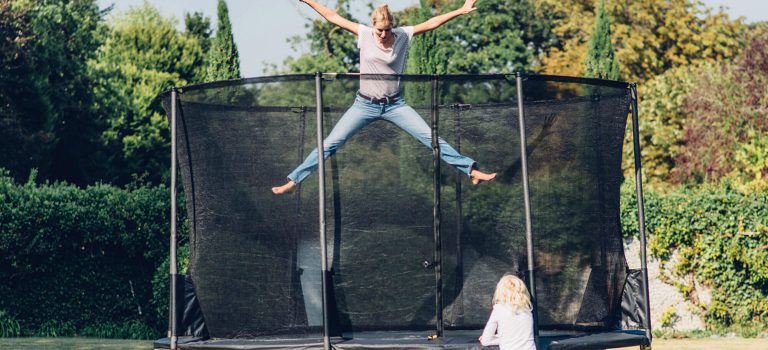Trampolines really are a fan favourite for everyone in the family, and really, who could be surprised? They’re an endless source of fun that requires no power, no water, and no effort from the parents once they’re set up. And obviously, the kids just love them. But all of this hinges on one crucial little task just at the start of your trampoline ownership; that is, of course, the set-up.
The importance of correct trampoline setup can’t be understated, as it is the primary thing that ensures safe play all day, every day. In this guide, we’ll be covering some of the key components of the trampoline and providing a general overview of what to do during the setup process. Let’s get into it.
The Parts of a Trampoline
Before you get cracking on building your trampoline, it’s important to have some idea of what components you’ll be dealing with prior to construction. In fact, we’re hoping that this information may even serve as something of a buying guide prior to purchase.
Springs
The springs of a trampoline are the unsung heroes, providing the essential bounce and support for every leap and bound. High-quality springs are crucial for maintaining both the fun factor and safety. They should be robust, rust-resistant, and properly installed to ensure a consistent and safe bouncing experience.
Plum Play’s Springsafe® technology is a prime example, offering an innovative design that enhances safety by keeping the springs external to the jumping area. This not only improves performance but also significantly reduces the risk of spring-related injuries, ensuring a worry-free playtime.
Mat
The trampoline mat is the heart of the bouncing experience. It’s where all the fun happens, so its quality and durability are paramount. Made from strong, UV-resistant fabrics, it should provide a smooth, consistent bounce while ensuring safety. When setting up, ensure the mat is free from tears or weaknesses and is correctly attached to the springs. Regular checks and maintenance are essential to keep it in top condition, ensuring it remains the safe and thrilling centrepiece of your trampoline.
Cover
A trampoline cover is an indispensable accessory for any trampoline owner. Designed to shield your trampoline from the elements, the cover plays a vital role in prolonging the life of your trampoline. It protects the mat, springs, and padding from rain, sun, and debris, keeping them in top condition.
When selecting a cover, ensure it fits snugly and is made of durable, weather-resistant material. Fitting the cover is straightforward; it should securely encompass the entire trampoline, providing a shield against wear and tear caused by harsh weather conditions.
Netting
Safety netting is a critical component of a modern trampoline, acting as a safeguard to prevent falls. This is particularly important for children, as the netting provides an extra layer of protection during play. When choosing netting, look for strong, durable materials that can withstand the impact of jumpers and resist wear over time.
Proper attachment is key – the netting should be securely fastened to the poles and the edge of the trampoline, leaving no gaps. Quality netting not only enhances safety but also gives parents peace of mind, knowing their children can enjoy their bouncing adventures safely.
How to Set Up a Trampoline
Setting up a trampoline can be a straightforward process when you follow these essential steps. Here’s a general guide to help you through each stage, ensuring a safe and enjoyable trampoline experience for everyone.
1. Reviewing the Materials
Before diving into the assembly, it’s crucial to review all the materials and parts provided. Lay out the pieces and cross-check them with the instruction manual to ensure everything is accounted for. This step helps identify any missing or defective components before assembly begins, saving time and ensuring safety. Pay special attention to the springs, mat, frame, and netting, as these are key elements of your trampoline.
2. Assembling the Trampoline Frame
The trampoline frame forms the foundation of your trampoline, so it’s important to assemble it correctly. Start by connecting the pieces of the frame, usually in a circular shape, ensuring each section is tightly and securely fastened. If your trampoline is oval or rectangular, make sure the longer and shorter sides are correctly positioned. The legs should then be attached, providing stable support. Double-check all connections for stability before moving to the next step.
3. Setting up the Mat
Once the frame is in place, the next step is to set up the jumping mat. Begin by attaching the springs to the mat, then carefully connect them to the frame. This can require a bit of strength and patience, as the springs need to be stretched to hook onto the frame. It’s crucial to evenly distribute the springs around the frame to maintain balance and tension across the mat. Ensure that each spring is properly hooked and secure for optimal safety.
4. Putting Together the Enclosure Net
The final step is to install the enclosure net, which is vital for safety. Start by attaching the poles around the trampoline, ensuring they are upright and firmly secured. Then, attach the netting to these poles, following the instructions to ensure it is tight and free of gaps. The net should cover the entire circumference of the trampoline and be secured at the top and bottom, preventing any falls or injuries.
Remember, safety is paramount when setting up a trampoline. Take your time, follow the instructions carefully, and don’t hesitate to ask for help if needed. Once set up, your trampoline will provide endless hours of fun and exercise. If you have any questions about the content covered in this guide, feel free to contact our team!

